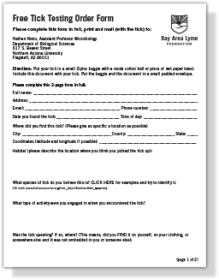"Our goal at Bay Area Lyme Foundation is to provide individuals with free, timely information as to whether a tick they have encountered is — an infected or uninfected tick.
Why Are We Offering Free Testing?
Sending us your tick(s) allows our scientific researchers to gather data about ticks from all over the United States. Our scientists can broaden their investigations into tick populations and glean information on the current distribution of the major tick vectors and the prevalence of tick-borne pathogens that people encounter in different locations. By sending us your tick(s) you are participating in a citizen science project and national tick-collection/testing effort which will enable our scientists to compare past and potential future distributions of ticks and tick-borne disease. Our hope is that by collecting this data, we may be able to predict where risk of disease is most common.

How it works
The tick can be dead or alive, but ideally collected less than 72 hours ago. Put your tick in a small Ziploc baggie with a moist cotton ball or piece of wet paper towel. If you have access to a small vial and alcohol, you can use that instead. Click on the image at right to download the 2-page PDF, fill it out completely, electronically or print and fill out by hand. Put the baggie and the document in a small padded envelope.
Identify your tick
Click here for images of some of the different tick species in North America. Try and identify what species of tick you are sending to us and indicate this in your document. Don’t worry if you can’t determine the species.
Send your tick along with the signed paperwork via regular US mail to:
Nathan Nieto, Assistant Professor Microbiology
Department of Biological Sciences
617 S. Beaver Street
Northern Arizona University
Flagstaff, AZ 86011
Considerations
It’s important to understand a bit about tick testing when you send us a tick:
- Tick testing is highly accurate—we are using qPCR DNA based tests following column based extractions that are very specific and sensitive (no test is 100% and is the result of sampling error, extraction error and qPCR error). While our test is very good, it cannot be 100%.
- Ticks carry a number of different kinds of microbes, not just the bacteria (Borrelia burgdorferi) that causes Lyme disease
- Ticks will be tested for 6 pathogens: Borrelia burgdorferi, which causes Lyme disease; Borrelia miyamotoi, which causes tick-borne relapsing fever; Anaplasma phagocytophilum, which causes human granulocytic anaplasmosis, Ehrlichia chafeensis, which causes human monocytic erhlichiosis, and Rickettsia rickettsii, the agent of Rocky-mountain spotted fever, and the protozoan pathogen, Babesia microti.
- If you are sending us a tick that you FOUND—for example crawling on a blade of grass, or climbing up your leg, we still want the tick because we want as much data as possible
- If you are sending us a tick that BIT you, it’s important for you to know that even if the tick tests positive, that bacteria may NOT have been passed to you
- Either way, if you have been in a place where infected ticks—or any ticks—are present, you should always be watching yourself for symptoms. Why? Because sometimes you may have had another tick on your body for a number of days and you never even knew it
- If we test your tick, it tests positive for a pathogen that can cause human disease, and if this tick actually BIT you, you should consult a physician. You may want to get yourself tested, especially if you are feeling symptomatic
- Note: current diagnostic tools for Lyme and other tick-borne infections may give false negatives, so it’s important to be aware of your own physical health and seek continuing advice if you start to feel ill. Alternatively, some tests will give false positives, something you should also be aware of. See list of possible symptoms
How long will it take before I get my results?
Typically, we will test ticks and have results within 7-10 business days.
How will I learn the results?
You will receive an email from our laboratory that will detail the species we identified, and the list of positive and negative results.
What if I have questions about the findings?
Please feel free to contact the lab with any questions regarding the findings. Use the report number in the subject heading of an email so that we may track your report and respond in a timely manner.
Lastly, when you send us a tick, you will be asked to download, fill out and print out this form and send it to us WITH your tick. You must complete the form in full and sign it correctly."
